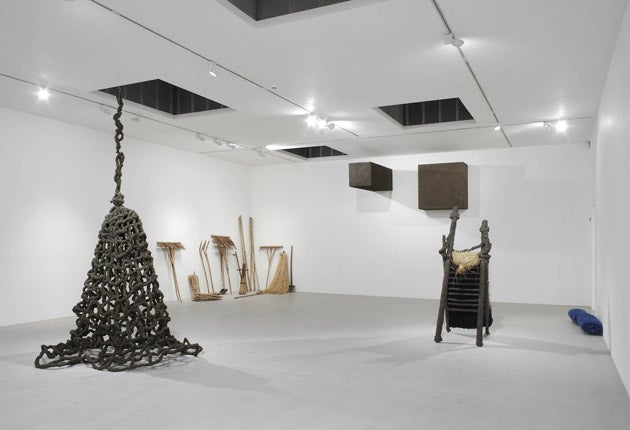Pino Pascali, Camden Arts Centre, London
An experimental Italian sculptor who died at only 32 left a joyous legacy that celebrates the world of work itself

A show of last works implies grand old age, the blurred late lily-ponds of Monet at Giverny or the austerity of a 90-year-old Willem de Kooning.
The sculptures on show at the Camden Arts Centre this month are the last works of Pino Pascali. In September 1968, the year in which they were all made, Pascali was killed while riding his motorbike through Rome. He was 32. He had liked to refer to his sculptures as "tombs". He turned out, alas, to be right.
This lends an inevitable sadness to an art that might otherwise be quite cheery. If "last works" suggests old age, then "tombs" calls up marble or bronze. Pascali's favoured material was Brillo pads, although he could do a nice line in blue acrylic scrubbing brushes when he put his mind to it. His taste for the demotic marks him down as a follower of Arte Povera, an Italian movement named by the critic Germano Celant in 1967.
Rejecting the materialism of post-war Italy, a vein richly mined by the films of Fellini, Arte Povera – literally, "poor art" – turned to materials formerly seen as below the artistic salt, if not beyond the Pale: house bricks, say, or dirt or sacks of rice. This identification with the lowly had an obvious political agenda, although rewriting the rules about materials gave Arte Poverists the freedom to break out in other ways as well. Their experiments are often seen as a preamble to conceptualism, and reasonably so.
So you might approach Pascali's Camden show with no particular spring in your step, the words "tomb" and "left-wing" adding up to something a bit grim. Actually, the only grimness in Pascali's art is in its reminder of what has been lost. His early death means that he is not nearly as well-known as other Arte Povera artists such as Mario Merz or Michelangelo Pistoletto, and, given the smallness of his surviving oeuvre, he probably never will be. Which is a great sadness, for this exhibition is a memento of his brilliance.
Protestant English makes no distinction between "work" as a verb and a noun, the one being the result of the other. A work of art is made by work. Italian, more grandly, separates the two. To work is lavorare, an artwork is an opera d'arte. The particular genius of Pascali was to elide these two, his work being, on several levels, about work.
Thus an extraordinary piece called Trappola ("Trap"), hung from the gallery ceiling. In form, Trappola is a large net – say, four metres high by two wide at its base – and has clearly been braided by hand. (By whose, I cannot say. Whether Pascali did his own braiding is not especially relevant.) It is an amazingly dense image, a conflation of many things. As often in Pascali's sculpture, it is made of steel wool, a material in turn made for hard work – scrubbing, scouring, what have you. Trappola's making must itself have involved someone in a great deal of work, much of it I would guess rather unpleasant: Brillo pads are not forgiving things. The end result of all this lavoro is an opera – a "lavera", maybe, or an "opovo"? – a work of art, a work of work.
What particularly strikes you about the piece is its lack of humbug. Trappola is certainly large-scale, and nets have a place in classical mythology. But Pascali's sculpture is the opposite of those Soviet monuments to the heroic working man. Its subject is a kind of grandeur, but it is a grandeur built of pain, entrapment.
The same is true of Attrezzi Agricoli ("Farm Tools"), propped up against a gallery wall as if against a barn. Here is the whole myth of Italian rural life summed up in objects that, like the myth itself, may or may not be true. Are these actual wooden rakes and brooms, collected by the artist as Duchamp collected bottle racks? Or has Pascali, or someone, laboured to make them?
The attrezzi are certainly made for (and by) work, but they also look like instruments of torture, many-toothed, blistering to the hand. Pascali's Bachi da setola play with pain in the same way. Bachi da seta are silkworms, bachi da setola are bristle worms: the young, dead Italian's sculpture, made of blue acrylic brushes, wriggle across the floor, or maybe writhe. Like their spidery cousin Vedova Blu ("Blue Widow"), they are funny, but not quite. Their punning title takes us from silk to sink in two letters, from luxury to labour. They are wonderful things, and this is a wonderful show. See it while you can.
To 1 May (020-7472 5500)
Next Week:
Charles Darwent gets down and squiggly with Joan Miró at Tate Modern
Art Choice
Indulge yourself with two rather decadent exhibitions. The Cult of Beauty: The Aesthetic Movement 1860-1900 is at London's V&A (to 17 Jul), with Pre-Raphaelite paintings, lavish interiors and beautiful books. Birmingham Museum and Art Gallery shows The Poetry of Drawing, in which you can chart the brotherhood's early days, with a swirl round the founders' romantic drawings (to 15 May).
Subscribe to Independent Premium to bookmark this article
Want to bookmark your favourite articles and stories to read or reference later? Start your Independent Premium subscription today.

Join our commenting forum
Join thought-provoking conversations, follow other Independent readers and see their replies